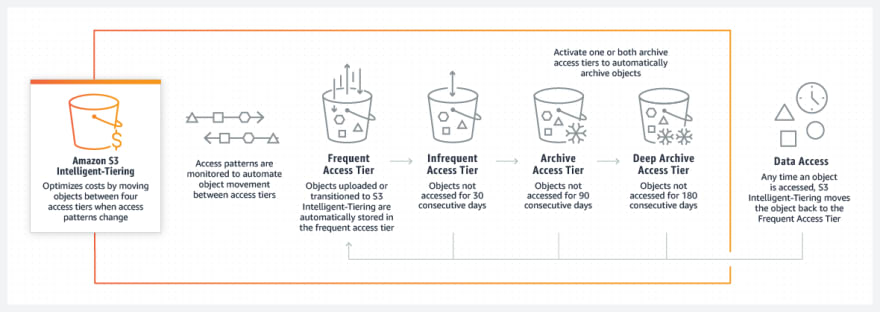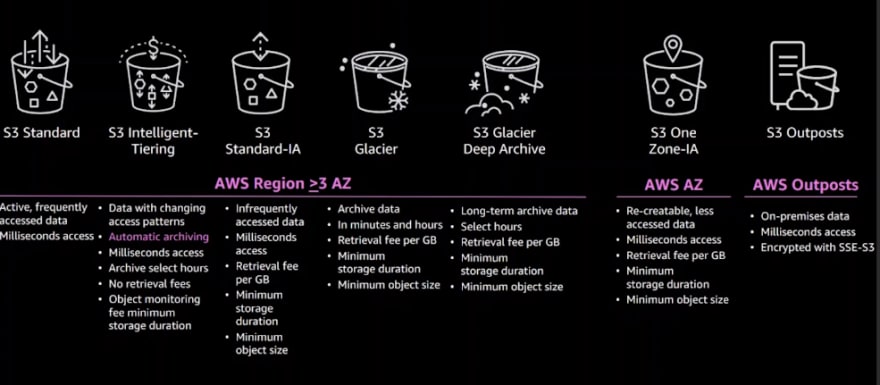Archive Access Tiers in Intelligent-Tiering
In 2020 S3 has launched new archive in deep archive access tiers, to intelligent tiering storage class, because customers wanted flexibility to automatically moving data to the lowest storage cost offering
In order to further reduce their storage costs, many customers prefer to archive rarely accessed objects directly to S3 Glacier or S3 Glacier Deep Archive. However, this requires you to build complex systems that understand the access patterns of objects for a long period of time and archive them when the objects are not accessed for months at a time.
Today we are announcing two new archive access tiers designed for asynchronous access that are optimized for rare access at a very low cost: Archive Access tier and Deep Archive Access tier. You can opt-in to one or both archive access tiers and you can configure them at the bucket, prefix, or object tag level.
Now with S3 Intelligent-Tiering, you can get high throughput and low latency access to your data when you need it right away, and automatically pay about $1 per TB per month when objects haven’t been accessed for 180 days or more. Already customers of S3 Intelligent-Tiering have realized cost savings up to 40% and now using the new archive access tiers they can reduce storage costs up to 95% for rarely accessed objects.
• Archive Access tier (NEW): It has the same performance and pricing as S3 Glacier storage class.
• Deep Archive Access tier (NEW): It has the same performance and pricing as S3 Glacier Deep Archive storage class.
How does it work:
Once you have activated one or both of the archive access tiers, S3 Intelligent-Tiering will automatically move objects that haven’t been accessed for 90 days to the Archive Access tier, and after 180 days without being accessed to the Deep Archive Access tier. At any time that an object that is in one of the archive access tiers is restored, the object will move to the Frequent Access tier within a few hours and then it will be ready to be retrieved.
Objects in the archive access tiers are retrieved in 3-5 hours and if they are in the deep archive access tier within 12 hours. If you need access to an object in any of the archive tiers faster, you can pay for faster retrieval by selecting in the console expedited retrieval.
Amazon S3 Outpost
S3 also launched Amazon S3 outposts to meet customers requirement of keeping their data close to on-premise application
AWS Outposts customers can now use Amazon Simple Storage Service (S3) APIs to store and retrieve data in the same way they would access or use data in a regular AWS Region. This means that many tools, apps, scripts, or utilities that already use S3 APIs, either directly or through SDKs, can now be configured to store that data locally on your Outposts.
AWS Outposts are a fully managed service that provides a consistent hybrid experience, with AWS installing the Outpost in your data centre or colo facility. These Outposts are managed, monitored, and updated by AWS just like in the cloud. Customers use AWS Outposts to run services in their local environments, like Amazon Elastic Compute Cloud (EC2), Amazon Elastic Block Store (EBS), and Amazon Relational Database Service (RDS), and are ideal for workloads that require low latency access to on-premises systems, local data processing, or local data storage.
Find a quick glimpse of the existing storage classes
• S3 storage classes
• S3 standard – 99.99% availability and 99.99999999% durability
• S3 Infrequently Access – data that is accessed less frequently but need rapid access when needed. Lower fee than S3 but retrieval fee is charged
• S3 One zone - IA (RRS – the old version) – lower cost for infrequently accessed data, and stored in one zone only
• S3 Intelligent Tiering – Designed by Artificial Intelligence, AI decides how often the objects are used and they are moved to the most cost-effective access tier without performance impact or operational overhead
• S3 Glacier – cheaper than on premise data archival
• S3 Glacier Deep Achieve – lowest cost storage class where retrieval time of 12 hours is accepted






Top comments (0)